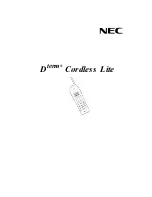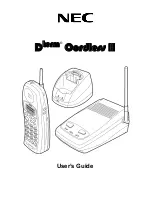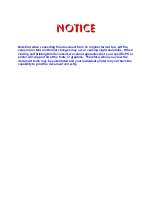
ATTENDANT CONSOLE USER GUIDE - 291
ATTENDANT CONSOLE
The Attendant Console (shown in Fig. 1) has been designed to provide
convenience and speed for the processing of incoming calls. There are 24
Feature keys that may be programmed for specific feature functionality or
outside line termination. Eight of these 24 keys have dual color (red and
green) lamps that are usually reserved for outside line termination. These
keys are frequently referred to as Float (FLT) or Loop keys. In addition to
these keys, there are 30 keys that can be programmed as Direct Station
Selection (DSS) keys. DSS keys provide one-touch access to call the system
extensions.
The Handset (Receiver) or Headset may be attached to either side of the
Attendant Console. If your organization has the requirement to train a new
attendant, a second Handset or Headset may be attached. Each side has the
option of either being in the talk or monitor mode by moving the
Talk/Monitor switch.
The Attendant Console also has two Lamp indicators. One is to inform you
if there is an alarm condition in the system. The other one is to inform you
of the number of calls waiting to be answered, up to 12 calls.
You will also notice that the Attendant Console has keys to adjust the
Handset, Ringer and Speaker volume.
The Attendant Console has a 4-line, 40 characters per line liquid crystal
display. The display provides call status information along with the date and
time. There is a Display Contrast switch on the right side of the Attendant
Console to compensate for different lighting conditions.
The display also provides a second function. It works in conjunction with six
Soft Function keys to enhance advanced feature operation. These Soft
Function keys have no fixed functionality. Their capabilities are interactive
with the prompts (words) that appear on the display.
Pressing a Soft Function key that corresponds to a prompt on the display
will result in a change of the prompts on the display.
Summary of Contents for Omegatrek PS6
Page 1: ......
Page 20: ...TABLE OF CONTENTS xvi IWATSU ENTERPRISE CS...
Page 21: ...Section 1 Iwatsu Enterprise CS General Description...
Page 22: ...GENERAL DESCRIPTION 2 IWATSU ENTERPRISE CS...
Page 78: ...GENERAL DESCRIPTION 58 IWATSU ENTERPRISE CS...
Page 79: ...Section 2 Iwatsu Enterprise CS Features...
Page 80: ...SYSTEM FEATURES 60 IWATSU ENTERPRISE CS...
Page 104: ...SYSTEM FEATURES 84 IWATSU ENTERPRISE CS...
Page 105: ...Section 3 IP Telephone User Guide...
Page 106: ...IP TELEPHONE USER GUIDE 86 IWATSU ENTERPRISE CS...
Page 164: ...IP TELEPHONE USER GUIDE 144 IWATSU ENTERPRISE CS...
Page 166: ...DIGITAL TELEPHONE USER GUIDE 146 IWATSU ENTERPRISE CS...
Page 276: ...DIGITAL TELEPHONE USER GUIDE 256 IWATSU ENTERPRISE CS...
Page 277: ...Section 5 Attendant Position User Guide...
Page 278: ...ATTENDANT POSITION USER GUIDE 258 IWATSU ENTERPRISE CS...
Page 308: ...ATTENDANT POSITION USER GUIDE 288 IWATSU ENTERPRISE CS...
Page 309: ...Section 6 Attendant Console User Guide...
Page 310: ...ATTENDANT CONSOLE USER GUIDE 290 IWATSU ENTERPRISE CS...
Page 344: ...ATTENDANT CONSOLE USER GUIDE 324 IWATSU ENTERPRISE CS...
Page 345: ...Section 7 SIP Single Line Telephone User Guide...
Page 346: ...SIP SINGLE LINE TELEPHONE USER GUIDE 326 IWATSU ENTERPRISE CS...
Page 369: ...Section 8 Digital Doorphone User Guide...
Page 370: ...DIGITAL DOORPHONE USER GUIDE 350 IWATSU ENTERPRISE CS...
Page 372: ...DIGITAL DOORPHONE USER GUIDE 352 IWATSU ENTERPRISE CS...
Page 373: ...Section 9 Direct Inward System Access DISA User Guide...
Page 374: ...DISA USER GUIDE 354 IWATSU ENTERPRISE CS...
Page 378: ...DISA USER GUIDE 358 IWATSU ENTERPRISE CS...
Page 379: ...Section 10 Hospitality Features User Guide...
Page 380: ...HOSPITALITY FEATURES USER GUIDE 360 IWATSU ENTERPRISE CS...
















































